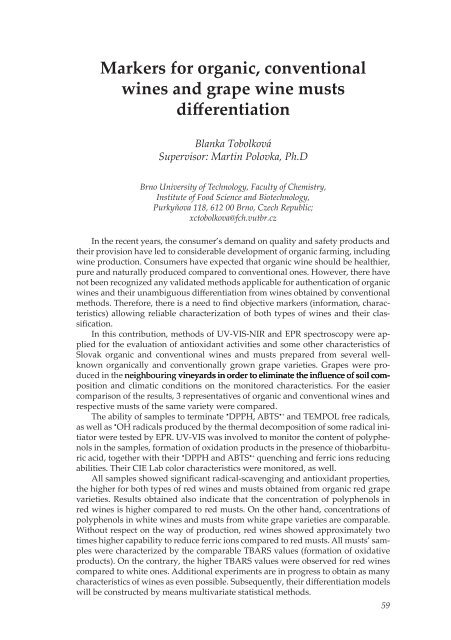Sborník abstraktů 2010 - Fakulta chemická - Vysoké učení technické ...
Sborník abstraktů 2010 - Fakulta chemická - Vysoké učení technické ...
Sborník abstraktů 2010 - Fakulta chemická - Vysoké učení technické ...
You also want an ePaper? Increase the reach of your titles
YUMPU automatically turns print PDFs into web optimized ePapers that Google loves.
Markers for organic, conventional<br />
wines and grape wine musts<br />
differentiation<br />
Blanka Tobolková<br />
Supervisor: Martin Polovka, Ph.D<br />
Brno University of Technology, Faculty of Chemistry,<br />
Institute of Food Science and Biotechnology,<br />
Purkyňova 118, 612 00 Brno, Czech Republic;<br />
xctobolkova@fch.vutbr.cz<br />
In the recent years, the consumer’s demand on quality and safety products and<br />
their provision have led to considerable development of organic farming, including<br />
wine production. Consumers have expected that organic wine should be healthier,<br />
pure and naturally produced compared to conventional ones. However, there have<br />
not been recognized any validated methods applicable for authentication of organic<br />
wines and their unambiguous differentiation from wines obtained by conventional<br />
methods. Therefore, there is a need to find objective markers (information, characteristics)<br />
allowing reliable characterization of both types of wines and their classification.<br />
In this contribution, methods of UV-VIS-NIR and EPR spectroscopy were applied<br />
for the evaluation of antioxidant activities and some other characteristics of<br />
Slovak organic and conventional wines and musts prepared from several wellknown<br />
organically and conventionally grown grape varieties. Grapes were pro-<br />
duced in the neighbouringvineyards in order to eliminate the influence of soil soil comcom-<br />
position and climatic conditions on the monitored characteristics. For the easier<br />
comparison of the results, 3 representatives of organic and conventional wines and<br />
respective musts of the same variety were compared.<br />
The ability of samples to terminate • DPPH, ABTS •+ and TEMPOL free radicals,<br />
as well as • OH radicals produced by the thermal decomposition of some radical initiator<br />
were tested by EPR. UV-VIS was involved to monitor the content of polyphenols<br />
in the samples, formation of oxidation products in the presence of thiobarbituric<br />
acid, together with their • DPPH and ABTS •+ quenching and ferric ions reducing<br />
abilities. Their CIE Lab color characteristics were monitored, as well.<br />
All samples showed significant radical-scavenging and antioxidant properties,<br />
the higher for both types of red wines and musts obtained from organic red grape<br />
varieties. Results obtained also indicate that the concentration of polyphenols in<br />
red wines is higher compared to red musts. On the other hand, concentrations of<br />
polyphenols in white wines and musts from white grape varieties are comparable.<br />
Without respect on the way of production, red wines showed approximately two<br />
times higher capability to reduce ferric ions compared to red musts. All musts’ samples<br />
were characterized by the comparable TBARS values (formation of oxidative<br />
products). On the contrary, the higher TBARS values were observed for red wines<br />
compared to white ones. Additional experiments are in progress to obtain as many<br />
characteristics of wines as even possible. Subsequently, their differentiation models<br />
will be constructed by means multivariate statistical methods.

















